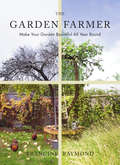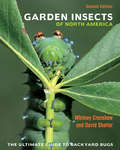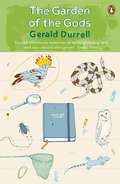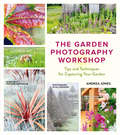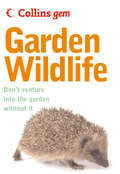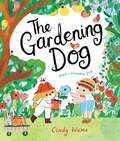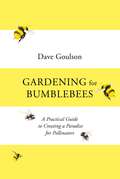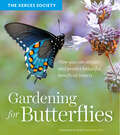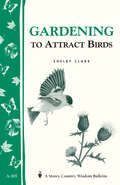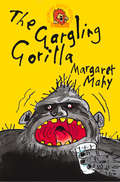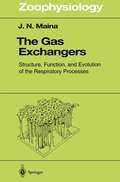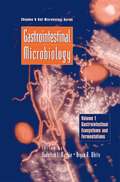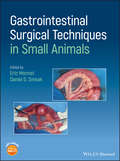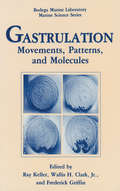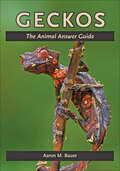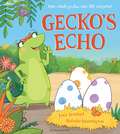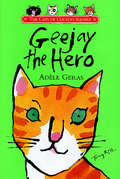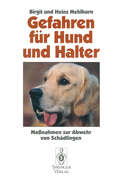- Table View
- List View
The Garden Farmer
by Francine RaymondSelected as a Book of the Year 2017 in You Magazine'A lavish monthly guide to getting the most from your garden' Daily MailA punnet of plums from your tree, a handful of gooseberries; home-grown nuts and herbs, and a few freshly laid eggs from your hens – all enjoyed in your own small plot. What could be more satisfying?The Garden Farmer is an evocative journal and monthly guide to getting the most out of your garden throughout the year. Whether you are a keen gardener looking for inspiration, or just starting out and wanting to rediscover and reclaim your patch of earth, Sunday Telegraph garden-columnist Francine Raymond lays the groundwork for a bountiful year of garden farming. Maybe you would like to get outside more, grow a few essential vegetables, some fruit trees or bushes for preserving, and create a scented kitchen garden to provide for you year round. Or perhaps you will raise a small flock of ducks or geese, or even a couple of pigs? Could this be the year you decorate your home with nature’s adornments, encourage wildlife back to pollinate your trees and plants, and spend celebratory hours in a haven of your own creation? Each chapter of The Garden Farmer offers insight into the topics and projects you might be contemplating that month, along with planting notes and timely advice, and a recipe that honours the fruits of your labour. With just a little effort and planning, every garden can be tended in tune with nature, and every gardener can enjoy a host of seasonal delights from their own soil.Keep up-to-date with Francine's gardening adventures on her blog at kitchen-garden-hens.co.uk.
Garden Insects of North America: The Ultimate Guide to Backyard Bugs
by Whitney Cranshaw David ShetlarThis second edition of Garden Insects of North America solidifies its place as the most comprehensive guide to the common insects, mites, and other “bugs” found in the backyards and gardens of the United States and Canada. Featuring 3,300 full-color photos and concise, detailed text, this fully revised book covers the hundreds of species of insects and mites associated with fruits and vegetables, shade trees and shrubs, flowers and ornamental plants, and turfgrass—from aphids and bumble bees to leafhoppers and mealybugs to woollybears and yellowjacket wasps—and much more. This new edition also provides a greatly expanded treatment of common pollinators and flower visitors, the natural enemies of garden pests, and the earthworms, insects, and other arthropods that help with decomposing plant matter in the garden.Designed to help you easily identify what you find in the garden, the book is organized by where insects are most likely to be seen—on leaves, shoots, flowers, roots, or soil. Photos are included throughout the book, next to detailed descriptions of the insects and their associated plants.An indispensable guide to the natural microcosm in our backyards, Garden Insects of North America continues to be the definitive resource for amateur gardeners, insect lovers, and professional entomologists.Revised and expanded edition covers most of the insects, mites, and other “bugs” one may find in yards or gardens in the United States and Canada—all in one handy volumeFeatures more than 3,300 full-color photos, more than twice the illustrations of the first edition Concise, informative text organized to help you easily identify insects and the plant injuries that they may cause
Garden Insects of North America: The Ultimate Guide to Backyard Bugs
by Whitney Cranshaw David ShetlarThis second edition of Garden Insects of North America solidifies its place as the most comprehensive guide to the common insects, mites, and other “bugs” found in the backyards and gardens of the United States and Canada. Featuring 3,300 full-color photos and concise, detailed text, this fully revised book covers the hundreds of species of insects and mites associated with fruits and vegetables, shade trees and shrubs, flowers and ornamental plants, and turfgrass—from aphids and bumble bees to leafhoppers and mealybugs to woollybears and yellowjacket wasps—and much more. This new edition also provides a greatly expanded treatment of common pollinators and flower visitors, the natural enemies of garden pests, and the earthworms, insects, and other arthropods that help with decomposing plant matter in the garden.Designed to help you easily identify what you find in the garden, the book is organized by where insects are most likely to be seen—on leaves, shoots, flowers, roots, or soil. Photos are included throughout the book, next to detailed descriptions of the insects and their associated plants.An indispensable guide to the natural microcosm in our backyards, Garden Insects of North America continues to be the definitive resource for amateur gardeners, insect lovers, and professional entomologists.Revised and expanded edition covers most of the insects, mites, and other “bugs” one may find in yards or gardens in the United States and Canada—all in one handy volumeFeatures more than 3,300 full-color photos, more than twice the illustrations of the first edition Concise, informative text organized to help you easily identify insects and the plant injuries that they may cause
The Garden of the Gods: My Family And Other Animals; Birds, Beasts And Relatives; And The Garden Of The Gods (The Corfu Trilogy #3)
by Gerald DurrellThe third book in The Corfu Trilogy (after My Family and Other Animals and Birds, Beasts and Relatives), the beloved books that inspired ITV's television series The Durrells.Just before the Second World War the Durrell family decamped to the glorious, sun-soaked island of Corfu where the youngest of the four children, ten-year-old Gerald, discovered his passion for animals: toads and tortoises, bats and butterflies, scorpions and octopuses. Through glorious silver-green olive groves and across brilliant-white beaches Gerry pursued his obsession . . . causing hilarity and mayhem in his ever-tolerant family.
The Garden Photography Workshop: Expert Tips and Techniques for Capturing the Essence of Your Garden
by Andrea JonesThe Garden Photography Workshop teaches basic photography skills and shares tips on using a range of camera equipment, covering everything from DSLRs to smartphones.
Garden Wildlife: Don't Venture Into The Garden Without It (Collins Gem)
by Michael ChineryFull of helpful expert advice and numerous practical projects, this is a fascinating mini guide to identifying and encouraging wildlife into your garden, whether you live in the town or the country.
The Gardening Dog
by Cindy WumeMeet two very special friends in this heartwarming and beautifully illustrated tale. Watch as a boy and a dog who don't quite fit in learn that a friendship, like a garden, takes time to grow - but that both are always worth the wait.The Gardening Dog is never chosen to go home with anyone who visits the rescue centre where she lives. Instead she spends her time quietly growing beautiful plants. Then one day she meets a boy called Lewis, who much prefers drawing to running around with all the other children. Working together, Lewis and The Gardening Dog create a wonderful community garden for everyone to share – and as new shoots grow outside, they build a deep friendship that leads to a new start for them both.
Gardening for Bumblebees: A Practical Guide to Creating a Paradise for Pollinators
by Dave GoulsonFrom the Sunday Times bestselling author of A Sting In The Tale comes this practical guide to creating a paradise for pollinators.There are twenty six different species of bumblebees to be found in the UK, of around 250 species worldwide. Bumblebees are among the most important of our insects; these superb pollinators ensure that wildflowers set seed and reappear each year, and that our vegetable and fruit crops give us bountiful harvests. With the decline in the populations of our wild bees, these beloved creatures need looking after more than ever. Gardening for Bumblebees shows you how you can provide a refuge for bumblebees to feed, breed and thrive. No matter how large or small your space is, Dave Goulson shows you how you can make a pollinator-friendly haven. In this book you will learn the best trees, shrubs and flowers for pollinators, how to create the perfect nest and breeding site, and the best ways to control pests. Gardening For Bumblebees will encourage and inspire gardeners and allotmenters alike to make their patch more bee friendly. Praise for Dave Goulson'Dave Goulson... has perfected the art of turning the entomologist's technical expertise into easy-reading everyman's prose'Mark Cocker, Spectator'Goulson reminds himself that he 'began studying bumblebees not because they are important pollinators but because they are fascinating, because they behave in interesting and mysterious ways, and because they are rather loveable' Hannah Rosefield, Literary Review
Gardening for Butterflies: How You Can Attract and Protect Beautiful, Beneficial Insects
by The Xerces SocietyGardening for Butterflies is an optimistic call to arms by the experts at the Xerces Society that provides home gardeners with everything they need to create a beautiful, beneficial, butterfly-filled garden. This full-color guide is a must-have for anyone who wants to help bring back the butterflies!
Gardening to Attract Birds: Storey's Country Wisdom Bulletin A-205 (Storey Country Wisdom Bulletin)
by Shelby ClarkSince 1973, Storey's Country Wisdom Bulletins have offered practical, hands-on instructions designed to help readers master dozens of country living skills quickly and easily. There are now more than 170 titles in this series, and their remarkable popularity reflects the common desire of country and city dwellers alike to cultivate personal independence in everyday life.
The Gargling Gorilla
by Margaret MahyThree short zany stories, all featuring weird and wonderful animals with illustrations by Tony Ross.
The Gas Exchangers: Structure, Function, and Evolution of the Respiratory Processes (Zoophysiology #37)
by John N. Maina"Amongst animals, diversity of form and of environmental circumstances have given rise to a multitude of different adap tations subserving the relatively unified patterns of cellular metabolism. Nowhere else is this state of affairs better exem plified than in the realm of respiration". Jones (1972). The field of comparative respiratory biology is expanding almost exponentially. With the ever-improving analytical tools and methods of experimentation, its scope is blossoming to fascinating horizons. The innovativeness and productivity in the area continue to confound students as well as specialists. The increasing wealth of data makes it possible to broaden the information base and meaning fully synthesize, rationalize, reconcile, redefine, consolidate, and offer empirical validation of some of the earlier anecdotal views and interpretations, helping resolve the issues into adequately realistic and easily perceptible models. Occa sional reflections on the advances made, as well as on the yet unresolved prob lems, helps chart out new grounds, formulate new concepts, and stimulate inquiry. Moreover, timely assessments help minimize isolation among investiga tors, averting costly duplication of effort. This exposition focuses on the diversity of the design of the gas exchangers and gives a critical appraisal of the plausible or constrained the evolvement of respiration. The factors that have motivated cause-and-effect relationship between the phylogenetic, developmental, and en vironmental factors, conditions, and states which at various thresholds and under certain backgrounds conspired in molding the gas exchangers is argued.
Gastrointestinal Microbiology: Volume 1 Gastrointestinal Ecosystems and Fermentations (Chapman & Hall Microbiology Series)
by Roderick Mackie Bryan WhiteExtremely diverse and complicated bacterial and protozoan populations inhabit the rumen and intestinal tract of animals, and there is a delicate balance among the individual populations within this complex microbial community. This authoritative edited volume, the first in a two-volume set, reviews the gut environment and the fermentations taking place in animal digestive tracts. It is an essential source of reference for microbial ecologists and physiologists, medical microbiologists and gastroenterologists, biochemists, nutritionists, veterinarians and animal scientists, and wildlife ecologists.
Gastrointestinal Surgical Techniques in Small Animals
by Eric Monnet Dan SmeakGastrointestinal Surgical Techniques in Small Animals offers a highly detailed reference to surgical procedures in the gastrointestinal tract in dogs and cats. Each chapter describes the surgical techniques in depth, featuring high-quality illustrations depicting each step, and discusses tips and tricks for a successful surgery and potential complications. A companion website offers video clips demonstrating the procedures. Logically divided into sections by anatomy, each chapter covers indications, contraindications, and decision making for a specific surgery. Tips and tricks and potential complications are also covered. Describes techniques for canine and feline gastrointestinal surgery in detail Presents the state of the art for GI surgery in dogs and cats Includes access to a companion website with video clips demonstrating techniques Gastrointestinal Surgical Techniques in Small Animals is an essential resource for small animal surgeons and veterinary residents.
Gastrointestinal Surgical Techniques in Small Animals
by Eric Monnet Daniel D. SmeakGastrointestinal Surgical Techniques in Small Animals offers a highly detailed reference to surgical procedures in the gastrointestinal tract in dogs and cats. Each chapter describes the surgical techniques in depth, featuring high-quality illustrations depicting each step, and discusses tips and tricks for a successful surgery and potential complications. A companion website offers video clips demonstrating the procedures. Logically divided into sections by anatomy, each chapter covers indications, contraindications, and decision making for a specific surgery. Tips and tricks and potential complications are also covered. Describes techniques for canine and feline gastrointestinal surgery in detail Presents the state of the art for GI surgery in dogs and cats Includes access to a companion website with video clips demonstrating techniques Gastrointestinal Surgical Techniques in Small Animals is an essential resource for small animal surgeons and veterinary residents.
Gastrulation: Movements, Patterns and Molecules (Bodega Marine Laboratory Marine Science Series)
by Ray Keller Wallis H. Clark Jr. Frederick GriffinGastrulation is a fundamental process of early embryonic development. It involves virtually every aspect of cell and developmental biology and results in the formation of fundamental structural elements around which a developing animal's body plan is organized. As such it is not only an important process, but also one that is complicated and not easily dissected into its component parts. To understand the mechanisms of gastrulation one must acknowledge that gastrulation is fundamentally a biomechanical process (that is, a problem of cells generating forces in a three dimensional array, patterned in space and time such that appropriate tissue movements are executed). Three intertwined questions emerge: what cell activities generate forces, how are these cell activities patterned in space and time, and how are the resulting forces harnessed in three dimensional domains? To address these issues it is important to define and characterize regional cell behaviors and to learn how they are patterned in the egg and/ or by subsequent cell and tissue interactions. At the biochemical level, what are the cellular and extracellular molecules that control cell behavior? Finally, how are specific patterns of cellular activity integrated to produce tissue behavior? The task of answering the above questions, an immense task in itself, is compounded by the fact that the morphogenetic movements of gastrulation and their underlying mechanisms vary between different organisms.
Gazelle Footprint (large print)
by RnibThis is an image of a gazelle footprint. The image has been repeated on the page so that it can be cut vertically in the centre to give two copies. There is a locator dot shown, which will be at the top left of the page when the image is the correct way up. The front of the footprint is at the top of the image. An adult gazelle footprint can measure up to 7 centimetres (2.7 inches).
Gazelle Footprint (UEB contracted)
by RnibThis is an image of a gazelle footprint. The image has been repeated on the page so that it can be cut vertically in the centre to give two copies. There is a locator dot shown, which will be at the top left of the page when the image is the correct way up. The front of the footprint is at the top of the image. An adult gazelle footprint can measure up to 7 centimetres (2.7 inches).
Gazelle Footprint (UEB uncontracted)
by RnibThis is an image of a gazelle footprint. The image has been repeated on the page so that it can be cut vertically in the centre to give two copies. There is a locator dot shown, which will be at the top left of the page when the image is the correct way up. The front of the footprint is at the top of the image. An adult gazelle footprint can measure up to 7 centimetres (2.7 inches).
Geckos: The Animal Answer Guide (The Animal Answer Guides: Q&A for the Curious Naturalist)
by Aaron M. BauerQ: How do geckos walk across ceilings? A: Millions of hair-like setae on each foot.Q: Where do geckos come from? A: Throughout the world. Usually where it’s warm.Q: How many species of geckos are there? A: Close to 1,500 and counting!Q: What do they eat? A: Insects mostly. Discover the biology, natural history, and diversity of geckos—the acrobatic little lizards made famous by a car insurance ad campaign. Lizard biologist and gecko expert Aaron Bauer answers deceptively simple questions with surprising and little-known facts. Readers can explore color photographs that reveal the natural wonder and beauty of the gecko form and are further informed by images of how geckos live in their natural habitats. Although written for nonexperts, Geckos also provides a carefully selected bibliography and a new list of all known species that will be of interest to herpetologists. Anyone who owns a gecko, has seen them in the wild, or has wondered about them will appreciate this gem of a book.
Gecko's Echo
by Lucy Rowland Natasha RimmingtonOnce there was a geckoand she lived inside a cave.She was very, very smallbut she was also really brave.To stop sneaky animals stealing her precious eggs, Mummy Gecko threatens the wrath of ONE HUNDRED ANGRY GECKOS. But ... are there really one hundred geckos? And, if there aren't, how will she protect her family? A mischievous tale of trickery and motherly courage, perfect for fans of Little Beaver and the Echo and The Gruffalo.
Geejay the Hero
by Adèle GerasGeejay - a striking ginger tom with a thirst for adventure - takes matters into his own paws when he discovers a little boy next door who isn't allowed to play outside because of his allergies...
Geese (UEB uncontracted)
by Adrian FarnsworthThis page shows three geese seen from the side and facing to the left.
Gefahren für Hund und Halter: Maßnahmen zur Abwehr von Schädlingen
by Birgit Mehlhorn Heinz MehlhornDieses Buch wendet sich an interessierte Hundebesitzer und Hundeliebhaber. Anhand von Farbabbildungen, Schemata, Tafeln, einfachen Bestimmungsschl}sseln etc. werden die Fr}herkennung eines Parasitenbefalls, die Bek{mpfungs- und die Vorsichtsma~nahmen zur Selbsthilfe dargestellt. DerText ist allgemeinverst{ndlich und am}sant gestaltet.
Gehirn-Computer-Schnittstellen-Technologien: Beschleunigung der Neurotechnologie zum Nutzen der Menschen
by Claude ClémentDieses Buch befasst sich mit dem Bereich der Gehirn-Computer-Schnittstellen (BCI) und dem einzigartigen und besonderen Umfeld aktiver Implantate, die eine elektrische Schnittstelle zum Gehirn, zum Rückenmark, zu peripheren Nerven und zu Organen bilden. Im Mittelpunkt des Buches steht die Heilung und Rehabilitation von Patienten mit schweren neurologischen Beeinträchtigungen, von Lähmungen bis hin zu Bewegungsstörungen und Epilepsie, die oft eine invasive Lösung auf der Grundlage eines implantierten Geräts erfordern. Frühere Errungenschaften, aktuelle Arbeiten und Zukunftsperspektiven von BCI und anderen Interaktionen zwischen medizinischen Geräten und dem menschlichen Nervensystem werden aus pragmatischer Sicht ausführlich beschrieben. gibt einen Überblick über die Branche der aktiven implantierbaren medizinischen Geräte (AIMDs) und wie sie sich von kardialen zu neurologischen Anwendungen entwickelt Klare, leicht zu lesende Darstellung des Bereichs der Neurotechnologien zum Nutzen des Menschen Bietet leicht verständliche Erklärungen zu den technischen Grenzen, den physikalischen Eigenschaften von Implantaten im menschlichen Körper und realistischen langfristigen Perspektiven
